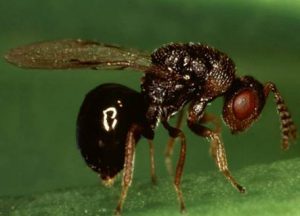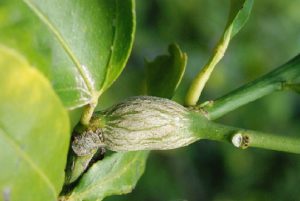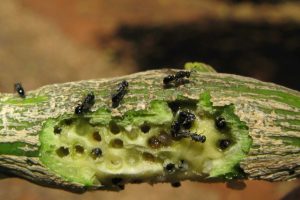Citrus Gall Wasp

Female Citrus Gall Wasp laying eggs
Many of our more determined garden pests are not native to Australia but the Citrus Gall Wasp (Bruchophagus fellis) is definitely an Australian grown garden variety pest. Initially, this native wasp was partial to Queensland and northern New South Wales and its favoured congregation was native finger limes. But the citrus gall wasp has quickly adapted to the broader variety of citrus fruits. Since the 1990’s it has successfully journeyed from Queensland, through NSW and can now be found as far south as Melbourne where it is virtually rampant on the iconic back yard lemon tree.
Adult citrus gall wasps are rarely seen as they are less than 3mm in size. The adults are meager flyers but can be windblown from other citrus trees nearby. The adult wasps mate in early to late spring when the female implants her eggs in the citrus tree that she herself emerged from just days before. Often the larvae are already present in newly purchased citrus trees in spring. The wasp larvae grow within the soft stem tissue for 9 to 12 months until they too pupate and emerge as adult wasps the next year.
Plants affected: All citrus trees, particularly lemons and grapefruit.
Damage Caused:

Wasp larvae growing inside the stem
The wasp larvae grow within the citrus stems until late summer when gardeners begin to notice unpleasant galls appearing on their trees. These galls or calluses are formed in response to the presence of the feeding larvae. Galls cannot be ‘cured’ or reversed. Old galls are unsightly but are also empty as the adult wasp will have left through the tiny exit holes. Developing galls can be removed but this may also mean the forfeiture of developing fruit at the end of the infected stem. Citrus gall is more damaging to younger citrus trees than older trees.
Control Methods: Controlling citrus gall wasp can be problematic but damage can be minimized by:
- Avoiding high nitrogen fertilizer in spring as this promotes soft sappy growth – just perfect for the egg laying stage. Feed trees in late autumn and early winter as an alternative.
- Removing all newly formed galls that don’t show signs of exit holes before the end of winter. Old galls have already been exited.
- Hanging yellow sticky traps inside infested trees from mid-August to trap emerging adult wasps. The yellow is an attractant and the sticky traps are impossible for the wasp to escape. Do not leave on after November as the wasps are no longer about and you may

Citrus Gall Wasp larvae hatching
unintentionally trap valuable insects and even small birds.
- Destroying plague-ridden stems by burning or soaking in water for a fortnight then bagging.
If you need help dealing with these ghastly creatures please don’t hesitate to call Jim’s Mowing on 0800 454 654 or book online for a free quote.


